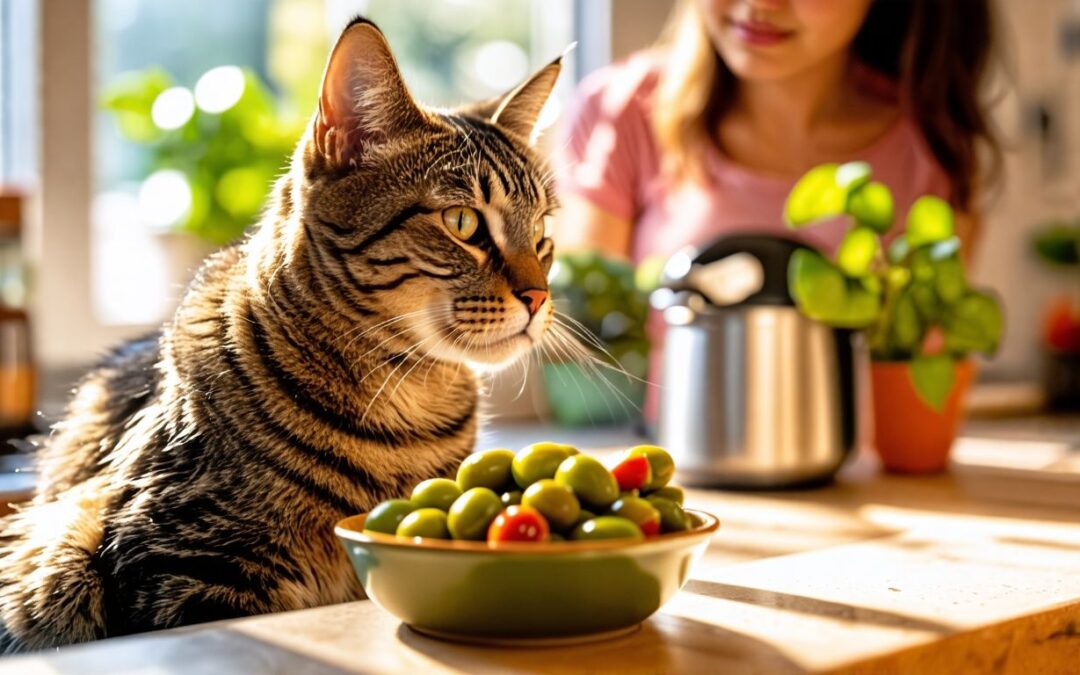Many cat owners wonder if it’s safe for their feline friends to munch on olives, especially those stuffed with pimentos. Thankfully, both olives and pimentos are not toxic to cats.
This blog post will guide you through the safety, benefits, and considerations of feeding olives with pimentos to your cat. Discover why this treat might just be a hit or miss for your furry companion!
Key Takeaways
- Cats can safely eat olives with pimentos as long as they are given in moderation. These snacks should not replace a cat’s balanced diet because they contain high sodium and provide little nutritional value.
- While olives and pimentos are not toxic to cats, too many can lead to health issues like excessive thirst or urinary problems due to their salt content. Always offer these treats sparingly.
- Some cats might be really attracted to olives because they contain compounds similar to those found in catnip. However, each cat reacts differently, so it’s essential to watch how your pet responds.
- There are plenty of cat-safe fruits and vegetables that make healthy alternatives to olives. Options like blueberries, pumpkin, carrots, and cucumbers can add variety and nutrients without the risks associated with high salt content.
- Homemade treats using safe ingredients like chicken, salmon, peas, or even small amounts of olive oil mixed with other flavors offer fun ways to treat your cat without compromising their health.
Can Cats Eat Olives With Pimentos?
Cats can eat olives with pimentos, but caution is key. Some ingredients may harm their health if consumed in large amounts.
Safety Concerns
Olives with pimentos are safe for cats to consume, as neither is toxic. However, caution is necessary due to their high sodium content and possible additives, which can lead to health issues if consumed excessively.
Offering olives should be done in moderation. These treats should never replace a balanced diet, as they provide minimal nutritional value compared to cat food options.
While many cats find the taste appealing, some may show no interest at all. It’s vital to monitor their intake closely and consult a veterinarian before introducing new foods like olives or pimentos into their diet.
Potential Benefits
Cats can enjoy olives with pimentos without facing any harmful side effects, as both foods are not toxic to them. Pimento-stuffed olives are particularly suitable for feline consumption since they don’t pose health risks.
These tasty treats contain isoprenoids similar to nepetalactone, the compound found in catnip, which might explain why some cats show a strong interest in olives. Offering these snacks in moderation allows cats to benefit from their flavor without compromising their overall diet.
Including such treats occasionally can add variety and excitement to a cat’s life. While olives should not be a significant part of a cat’s diet, small amounts provided as an occasional treat can be enjoyable.
Cats mainly thrive on balanced meals tailored for their nutritional needs, but enjoying safe human food like pimentos and olives expands their palate while ensuring safety and satisfaction.
Risks of Overconsumption
Feeding olives with pimentos to cats can lead to several risks if consumed in excess. Olives have a high sodium content, which can be harmful for cats. Overconsumption may result in excessive thirst or urinary issues due to increased salt intake.
Although olives and pimentos are not toxic, they should not make up a significant portion of a cat’s diet. Moderation is key; too many treats could disrupt the balance of nutrients needed for their health.
It’s crucial to monitor how much your feline friend enjoys this snack and consult with a veterinarian before introducing any new food items like olives or pimentos into their regimen.
Why Are Cats Obsessed with Olives?
Cats often find olives very appealing. The strong smell and unique texture attract them, making olives a favorite treat for many felines.
Taste Preferences
Cats show unique taste preferences, and many are attracted to olives and pimentos. The compounds found in these foods, particularly isoprenoids, resemble nepetalactone— the substance in catnip that drives felines wild.
This similarity may explain why some cats display a strong interest in olives while others remain indifferent. Although not toxic, olives should only be offered as an occasional treat rather than a staple of their diet.
Monitoring your cat’s reaction is essential to ensure they enjoy this special snack without overindulgence or adverse effects.
Understanding why cats gravitate towards certain foods can enhance mealtime experiences for both pets and owners alike.
Odor Attraction
Many cats are drawn to the distinct aroma of olives and pimentos. These foods contain isoprenoids, which are similar in structure to nepetalactone, the compound found in catnip. This similarity can make olives especially appealing to some felines.
Despite their interest, it’s essential to understand that not all cats will react the same way. Some may show a strong liking for olives with pimentos, while others might completely ignore them.
While these foods aren’t toxic for cats, ensuring they consume them in moderation is crucial for their health and well-being.
Nutritional Benefits
Olives and pimentos offer some nutritional benefits for cats. They contain isoprenoids, which are similar to nepetalactone found in catnip. This similarity explains why many cats show a strong attraction to olives.
While olives are safe for cats to eat, they should only be offered occasionally due to their high sodium content and potential additives. These treats should not replace a balanced diet, as olives should not make up a significant portion of a cat’s meals or snacks.
Moderation in feeding olives, including both green and black varieties, is essential for maintaining feline health while allowing them to enjoy these flavorful bites.
Alternatives to Olives for Cats
Cats can enjoy a variety of safe fruits and veggies instead of olives. Many options provide health benefits without the risks associated with human food. Exploring these choices can lead to new favorites for your feline friend.
Check out some tasty alternatives that will keep your cat happy and healthy!
https://www.youtube.com/watch?v=0kLTUGn3WHo
Cat-Safe Fruits and Veggies
Offering cat-safe fruits and vegetables can provide healthy alternatives for your feline friend. These options are not only safe but can also contribute to a balanced diet.
- Blueberries: These small fruits are packed with antioxidants and vitamins. They are safe for cats to enjoy in moderation and may promote good health.
- Pumpkin: Rich in fiber, pumpkin can aid digestion in cats. It is best served plain, without any added spices or sugar.
- Carrots: Cats can eat cooked carrots safely. They offer vitamins and minerals while being low in calories.
- Cucumbers: This crunchy vegetable is hydrating and low in calories. Many cats find cucumbers refreshing and tasty.
- Peas: Fresh or frozen peas add protein to your cat’s diet. They are safe and can be a fun treat for your pet.
- Watermelon: Without seeds, watermelon is a juicy option that many cats enjoy on hot days. Its high water content helps keep them hydrated.
- Zucchini: This summer squash can be offered raw or cooked to your cat. It’s low-calorie and provides essential nutrients.
- Spinach: In small amounts, spinach offers vitamins A, C, and K for cats’ diets. Ensure it’s fresh and free from harmful additives.
- Sweet Potatoes: Cooked sweet potatoes are rich in vitamins and safe for cats when given in moderation as a treat.
- Broccoli: This vegetable is safe for felines when steamed or chopped into tiny pieces. It contains fiber that supports digestive health without overwhelming their systems.
These offerings should provide enjoyment without overpowering a cat’s primary diet of balanced cat food.
Balanced and Nutritious Meals
Cats thrive on a balanced and nutritious diet. Their primary source of nutrition should come from high-quality cat food that meets their dietary needs. This ensures they receive essential nutrients, vitamins, and minerals crucial for their health.
While it’s safe for cats to eat olives with pimentos in moderation, these foods should not replace proper meals.
Olives should only be an occasional treat since they have high sodium content and potential additives that can harm cats if consumed excessively. A feline diet must consist mainly of meat-based proteins along with some cat-safe fruits and vegetables for added variety and benefits.
Treats like olives can be enjoyed by some cats due to the isoprenoids present in them, which are similar to compounds found in catnip; however, moderation is key to maintaining their overall health.
Homemade Treats
Creating homemade treats for your cat can be a fun way to provide variety in their diet. Using safe ingredients ensures your feline friend enjoys them without any health risks.
- Olive and Pimento Bites
Combine finely chopped olives with pimentos in a bowl. Shape the mixture into small, bite-sized balls. These treats are easy for cats to nibble on and can appeal due to their unique taste.
- Meat and Olive Flavors
Blend cooked chicken or turkey with a small amount of olive oil for extra flavor. Mix in some black or green olives to give it a special twist. Cats usually find this combination irresistible.
- Vegetable Mash Treats
Puree cat-safe veggies like carrots or peas with a bit of olive oil. Add chopped pimentos for added taste and color. This mash can serve as an occasional treat that provides nutritional benefits.
- Salmon and Olive Delights
Mix canned salmon (in water) with finely diced olives. Form this mixture into small patties, which you can bake until slightly firm. Most cats will love the rich flavor of salmon paired with olives.
- Frozen Olive Cubes
Puree olives together with some low-sodium chicken broth in a blender, then pour the mixture into ice cube trays and freeze them. These refreshing cubes can be great for warm days, making hydration fun.
- Oven-Baked Treats
Bake a batch using whole wheat flour mixed with olive oil, water, and shredded cheese if your cat likes dairy (in moderation). Cut these dough pieces into fun shapes before baking until golden brown.
- Herbed Olive Snacks
Incorporate cat-safe herbs like parsley with chopped olives to create tasty snacks packed with flavor. Roll them into small balls or shapes before serving them fresh.
- Pimento-Stuffed Fish Treats
Make fish-shaped treats using tuna, mixing it with finely chopped pimentos and forming them into little shapes before baking briefly to set them up while adding an appealing smell that attracts cats.
These homemade options offer enjoyable flavors while becoming healthier alternatives to store-bought treats that could contain additives not suitable for felines’ diets. Always keep moderation in mind when introducing new foods, including olives and pimentos!
Recommendations and Conclusion
Cats can safely enjoy olives with pimentos in moderation. These foods are not toxic and may even attract some feline friends due to their unique flavors. However, keep an eye on your cat’s intake and make sure it doesn’t become a regular part of their diet.
Always prioritize balanced cat food for overall health. Consult your vet before introducing new treats, including olives and pimentos, to ensure they fit well into your cat’s nutrition plan.
FAQs
1. Can cats safely consume olives?
Yes, both black and green olives are safe for cats to eat in moderation, but it’s always best to consult a vet for any changes in your cat’s diet.
2. Are pimentos found in olives poisonous to cats?
While pimentos aren’t typically toxic to cats, they may not be suitable for all felines. Always check with your vet before feeding pimentos or any human food to your cat.
3. What is the truth about cats’ obsession with olives?
Cats are often attracted towards the smell of olives which can sometimes be mistaken as an obsession; however, this doesn’t mean that all types of olives or their components like olive oil or pimentos should be part of their regular diet.
4. Do olives have health benefits for my cat?
Though some claim there might be health benefits of feeding small amounts of olives to cats, it’s important that these are fed only occasionally and never replace a balanced feline diet.
5. How much olive can I feed my cat?
Feeding too many olives could lead to health issues due its high fat content so moderation is key when giving them as treats.






